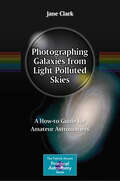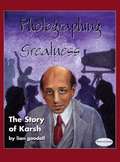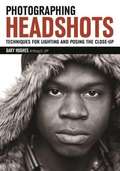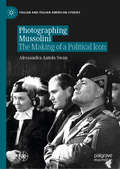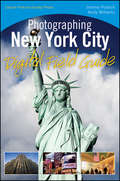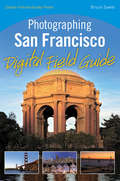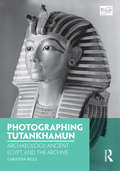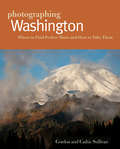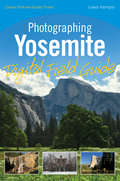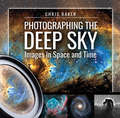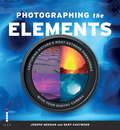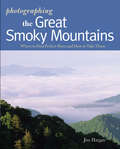- Table View
- List View
Photographing Families: Tips for Capturing Timeless Images
by Michele CelentanoCreate family portraits to cherish for a lifetime Family photographs are a staple of both amateur and professional photography. While always in demand, they also pose a unique set of challenges. In this book, Canon Explorer of Light Michele Celentano guides beginning- to intermediate-level photographers around the common pitfalls and helps them learn how to get top-quality shots every time. From getting families organized and directing the posing to managing large groups and impatient kids, this book reveals the secrets and helps you capture the shot without relying on post-production to achieve perfection. Whether you're a professional seeking to advance your knowledge or the family's designated picture-taker, you'll benefit from these professional tips. You'll learn camera techniques that can take pounds and years off your subjects and create images that stand the test of time. Family pictures are a photographic staple with their own set of challenges; this book offers tried-and-true advice for both hobbyists and professionals Veteran photographer and Canon Explorer of Light Michele Celentano guides you through getting families prepared for a photo session, directing the poses, handling challenging personalities, and creating memorable settings Helps you capture the perfect shot in the camera without relying on post-production to make it right Reveals secrets that can help your subjects shed pounds and years Packed with advice to help you keep your photos from showing up on awkwardfamilyphotos.com Photographing Families: Tips for Capturing Timeless Images is loaded with insider tips to help you make family portraits the treasure they should be.
Photographing Flowers: Exploring Macro Worlds with Harold Davis
by Harold DavisCapture stunning macro floral images with this gorgeous guide by acclaimed photographer Harold Davis. You'll learn about different types of flowers, macro equipment basics, and the intricacies of shooting different floral varieties in the field and in the studio. Harold also shows you techniques in the Photoshop darkroom that can be applied to flower photography to help you get the most out of your images. Beautiful and authoritative, this guide to photographing flowers is a must-read for every photographer interested in flower photography. Photographing Flowers will also win a place in the hearts of those who simply love striking floral imagery.
Photographing Galaxies from Light Polluted Skies: A How-to Guide for Amateur Astronomers (The Patrick Moore Practical Astronomy Series)
by Jane ClarkGalaxies present a unique challenge to town dwellers. Amateur astronomers can't use narrowband filters to shut out light pollution or use ordinary techniques as they would in dark, open fields. As one can imagine, this discrepancy with light means not everyone who looks up at the night sky is capable of seeing all it has to offer. What a shame! Author Jane Clark, however, has spent two years going down blind alleys trying to get a technique to work to combat the amateur astronomer's biggest enemy, light pollution. In this book, you will discover the fascinating variety of galaxies: spirals, ellipticals and irregular galaxies, often sculpted by gravity as they encounter one another in the vastness of space. You will also learn how to image them, as well! While the most decent images pick up background galaxies 10-20x as far, each containing billions of stars, that's just the local universe! This book will help you observe for yourself right in your own backyard, allowing you to get a sense of the sheer vastness of the universe.
Photographing Greatness: The Story of Karsh
by Lian GoodallYousuf Karsh emigrated to North America from Turkey in the 1920s, eventually settling in Ottawa. An early interest in photography inspired him to open his own studio. As he became known for the quality of his work, Karsh’s close proximity to powerful leaders in Ottawa led to commissions of portraits of politicians. He became known as the worlds’ finest portrait photographer for his gift of drawing out and capturing a subject’s character in a photograph. Over a seventy plus year career, Karsh photographed many famous musicians, artists, actors, captains of industry and politlcians. He was also a humanitarian who worked with sick children. This is the first children’s biography of the man who immortalized the makers of history.
Photographing Headshots
by Gary HughesHeadshots--images that include the subject’s head and shoulders--are big business for photographers. These types of images are needed by individuals from all walks of life--from business tycoons to actors and models. While most clients who book portrait sessions want images that document a moment in time, special event, or aspect of their personality (and file them away or share them with family or friends), headshots are very public. They grace annual reports, appear on business cards and websites, and take up prime real estate in the portfolios of those who seek to appear in fashion magazines, product ads, on stage, and on the screen. In short, clients need tailored images that speak of a business proficiency, appear pleasant, and simply communicate their core characteristics to viewers. In this book, Hughes provides solid lighting and posing techniques that will yield repeatable, polished portrait results that please subjects and get them noticed.
Photographing Jewish Weddings: A Complete Handbook for Professionals
by Stan TurkelA guide to the culture and traditions of Judaic ceremonies and receptions, this study offers photographers insight and advice for targeting and capturing Jewish weddings. Time lines and schedules are discussed with examples of start-to-finish wedding-day festivities, and a list of the essential images for the different types of weddings#151;such as Orthodox, Hasidic, Modern, Reform, and Conservative#151;emphasize the key elements photographers are not to miss. A special #147;Marketing 101 for Jewish Weddings” section helps photographers reach these potentially lifelong clients and reveals how these weddings, which sometimes fall on weekdays, can boost sales.
Photographing Mussolini: The Making of a Political Icon (Italian and Italian American Studies)
by Alessandra Antola SwanThis pioneering book offers the first account of the work of the photographers, both official and freelance, who contributed to the forging of Mussolini's image. It departs from the practice of using photographs purely for illustration and places them instead at the centre of the analysis. Throughout the 1930s photographs of the Italian dictator Benito Mussolini were chosen with much care by the regime. They were deployed to highlight those physical traits - the piercing eyes, protruding jaw, shaved head - that were meant to evoke the Duce's strength, determination and innate sense of leadership in the mind of his contemporaries. The chapters in this volume explore the photographic image in the socio-political context of the time and shows how it was a significant contributor to the development of Italian mass culture between the two world wars.
Photographing New York City Digital Field Guide
by Andy Williams Jeremy PollackTake memorable photos of the most popular attractions in the Big Apple!Whether using a point-and-shoot or a high-end dSLR, this companion guide provides you with detailed information for taking amazing shots of one of one of the world's most photographed cities. Whether you aim to capture the regal Empire State Building, vibrant Times Square, historic Grand Central Station, massive Central Park, or one of New York City's many other landmarks, this portable resource goes where you go and walks you through valuable tips and techniques for taking the best shot possible. You'll discover suggested locations for taking photos, recommended equipment, what camera settings to use, best times of day to photograph specific attractions, how to handle weather challenges, and more. In addition, beautiful images of New York City's most breathtaking attractions and recognizable landmarks serve to both inspire and assist you as you embark on an amazing photographic adventure!Elevates your photography skills to a new level with photography secrets from professional photographer and SmugMug COO, Andy Williams Presents clear, understandable tips and techniques that span all skill levels, using all types of digital cameras, from full-featured compact cameras to high end DSLRsFeatures New York City's main attractions in alphabetical order as well as thumb tabs on the pages so you can quickly and easily access the information you are looking forShares detailed information and insight on critical topics, such as ideal locations to photograph from, the best time of day to shoot, camera equipment to have handy, weather conditions, and optimal camera settings to considerWhether you're a local familiar with the territory or a visitor seeing the Big Apple for the first time, this handy guide will help you capture fantastic photos!
Photographing Newborns
by Mimika CooneyIn this comprehensive book, Cooney touches on each facet of being a successful newborn portrait photographer. She begins by outlining the foundation of her business model and provides insight for the reader to establish something similar for their business. Defining your target market and ideal customer profile are essential to guiding your business in the right direction. Cooney focuses her business, and this book, on what she calls a 'boutique’ brand. These are pricier photo shoots and packages, which require more time and care. Working with clients at this level often creates a lasting relationship and hopefully, repeat business. This is where the branding of your business is so important. Not only can it deliver regular clients, but can also inspire important word-of-mouth references. Emphasizing how important it is for a photography studio to have structure and direction to become and remain successful, Cooney walks the reader through many scenarios that have helped form her business. A strong social media presence, creative marketing & promotions and repeat customers are the key to standing apart from the competition, therefor remaining vital.
Photographing Newborns
by Mimika CooneyIn this comprehensive book, Cooney touches on each facet of being a successful newborn portrait photographer. She begins by outlining the foundation of her business model and provides insight for the reader to establish something similar for their business. Defining your target market and ideal customer profile are essential to guiding your business in the right direction. Cooney focuses her business, and this book, on what she calls a 'boutique’ brand. These are pricier photo shoots and packages, which require more time and care. Working with clients at this level often creates a lasting relationship and hopefully, repeat business. This is where the branding of your business is so important. Not only can it deliver regular clients, but can also inspire important word-of-mouth references. Emphasizing how important it is for a photography studio to have structure and direction to become and remain successful, Cooney walks the reader through many scenarios that have helped form her business. A strong social media presence, creative marketing & promotions and repeat customers are the key to standing apart from the competition, therefor remaining vital.
Photographing San Francisco Digital Field Guide
by Bruce SawleA compact, full-color companion guide to photographing San Francisco! Whether using a full-featured compact camera or a high-end dSLR, this companion guide provides you with detailed information for taking stunning shots of beautiful San Francisco. Whether you aim to capture breathtaking photos of the majestic Golden Gate Bridge, crooked Lombard Street, infamous Alcatraz, or unique Victorian homes, this portable resource goes where you go and walks you through valuable tips and techniques for taking the best shot possible. You'll discover suggested locations for taking photos, recommended equipment, what camera settings to use, best times of day to photograph specific attractions, how to handle weather challenges, and more. In addition, lovely images of San Francisco's most breathtaking attractions and recognizable landmarks serve to both inspire and assist you as you embark on an amazing photographic adventure! Elevates your photography skills to a new level with photography secrets from professional photographer Bruce Sawle Presents clear, understandable tips and techniques that span all skill levels, using all types of digital cameras, from compacts to high end DSLRs Features San Fransisco's main attractions in alphabetical order as well as thumb tabs on the pages so you can quickly and easily access the information you are looking for Shares detailed information and insight on critical topics, such as ideal locations to photograph from, the best time of day to shoot, camera equipment to have handy, weather conditions, and optimal camera settings to consider Whether you're a local familiar with the territory or a visitor seeing San Francisco for the first time, this handy guide will help you capture fantastic photos!
Photographing Shadow and Light: Inside the Dramatic Lighting Techniques and Creative Vision of Portrait Photographer Joey L.
by Joey L. David HobbyAspiring photographers are always looking for that edge, that fresh point of view to add drama to their images. Photographer Joey L. found his vision early, drawing critical acclaim as a brilliant commercial photographer with a distinctive technical expertise for lighting. In Photographing Shadow and Light, Joey lifts the curtain on his dramatic, creatively fearless approach to portraiture, sharing his personal philosophy and a behind-the-scenes look at 15 striking photo sessions--from personal projects shot in Africa, India, and Brooklyn to commercial shoots for 50 Cent, the Jonas Brothers, and Project Runway All Stars. Joey provides readers with a step-by-step description of how he visualized each shoot, formed meaningful connections with his subjects, and "built" his signature dramatic lighting effects--one light at a time. Featuring more than 85 stunning portraits, detailed lighting diagrams, and a foreword from industry icon David Hobby (aka Strobist), Photographing Shadow and Light shares the creative process behind one of today's most exciting photography talents, providing serious amateurs and professionals a fresh perspective on creating compelling, professional quality portraits. "Joey Lawrence is . . . the future of photography. Get used to it." --David Hobby (Strobist) Get inside the images of commercial and fine art portrait photographer Joey L. with this behind-the-lens guide to his fearless approach, creative vision, and signature lighting techniques.Also available as an ebookFrom the Trade Paperback edition.
Photographing Tutankhamun: Archaeology, Ancient Egypt, and the Archive (Photography, History: History, Photography)
by Christina RiggsThey are among the most famous and compelling photographs ever made in archaeology: Howard Carter kneeling before the burial shrines of Tutankhamun; life-size statues of the boy king on guard beside a doorway, tantalizingly sealed, in his tomb; or a solid gold coffin still draped with flowers cut more than 3,300 years ago. Yet until now, no study has explored the ways in which photography helped mythologize the tomb of Tutankhamun, nor the role photography played in shaping archaeological methods and interpretations, both in and beyond the field. This book undertakes the first critical analysis of the photographic archive formed during the ten-year clearance of the tomb, and in doing so explores the interface between photography and archaeology at a pivotal time for both. Photographing Tutankhamun foregrounds photography as a material, technical, and social process in early 20th-century archaeology, in order to question how the photograph made and remade ‘ancient Egypt’ in the waning age of colonial order.
Photographing Washington
by Gordon Sullivan Cathie SullivanDescribed as a nature photographer's paradise, Washington State presents amateur and professional photographers with an endless array of subjects, and there are no better guides to photographing here than Gordon and Cathie Sullivan, authors of twelve books on photography. Washington is home to four National Parks and National Monuments, the spectacular Pacific Coast Highway, the San Juan Islands, Columbia River basin, and a host of wildlife refuges. This is the rich palette from which the Sullivans have chosen 120 stunning sites to highlight the best times, seasons, and techniques for taking memorable photographs. This comprehensive photography guide includes sites of historical interest as well as natural beauty, with details of equipment, exposure, and technical and safety considerations.
Photographing Washington, D.C. Digital Field Guide
by John HealeyThe ideal companion guide for capturing awe-inspiring photos of Washington, D. C. ! Whether using a compact camera or a high-end dSLR, this companion guide provides you with detailed information for taking spectacular shots of some of the most recognizable architecture in the world. Whether you aim to capture memorable photos of the White House, U. S. Capitol, Washington Monument, Lincoln Memorial, or one of D. C. 's other many remarkable memorials, this portable resource goes where you go and walks you through valuable tips and techniques for taking the best shot possible. You'll discover suggested locations for taking photos, recommended equipment, what camera settings to use, best times of day to photograph specific attractions, how to handle weather challenges, and more. In addition, beautiful images of Washington, D. C. 's most breathtaking attractions and recognizable landmarks serve to both inspire and assist you as you embark on an amazing photographic adventure! Elevates your photography skills to a new level with photography secrets from professional photographer John Healey Presents clear, understandable tips and techniques that span all skill levels, using all types of digital cameras, from compact cameras to high end DSLRs Features Washington, D. C. 's main attractions in alphabetical order as well as thumb tabs on the pages so you can quickly and easily access the information you are looking for Shares detailed information and insight on critical topics, such as ideal locations to photograph from, the best time of day to shoot, camera equipment to have handy, weather conditions, and optimal camera settings to consider Whether you're a local familiar with the territory or a visitor seeing our nation's capital for the first time, this handy guide will help capture fantastic photos!
Photographing Waterdrops: Exploring Macro Worlds with Harold Davis
by Harold DavisCapturing the fleeting, dynamic world contained within the tiniest of water droplets is one of the most challenging photographic endeavors. Like many things, the challenge is worth the effort - when done with skill, these images can become some of the most unique shots you've ever taken. In this gorgeous guide packed with creative insipration alongside technical expertise, award-winning photographer Harold Davis shows you how he creates his stunning water drop images. From challenges to working with constantly moving subjects and reflected light to basic info on which equipment works best, this book will help all macro-loving photographers turn their lens on water, water, everywhere.
Photographing Yosemite Digital Field Guide
by Lewis KemperThe ideal companion guide for capturing awe-inspiring photos of Yosemite! Whether using a compact camera or a high-end dSLR, this companion guide provides you with detailed information for taking spectacular shots of some of the most recognizable landmarks in the world. Whether you aim to capture memorable photos of Half Dome, El Capitan, Vernal Fall, Mariposa Grove, or one of Yosemite's other many remarkable attractions, this portable resource goes where you go and walks you through valuable tips and techniques for taking the best shot possible. You'll discover suggested locations for taking photos, recommended equipment, what camera settings to use, best times of day to photograph specific attractions, how to handle weather challenges, and more. In addition, beautiful images of Yosemite's most breathtaking attractions and recognizable landmarks serve to both inspire and assist you as you embark on an amazing photographic adventure! Elevates your photography skills to a new level with photography secrets from professional photographer Lewis Kemper Presents clear, understandable tips and techniques that span all skill levels, using all types of digital cameras, from compact cameras to high end DSLRs Features Yosemite's main attractions in alphabetical order as well as thumb tabs on the pages so you can quickly and easily access the information you are looking for Shares detailed information and insight on critical topics, such as ideal locations to photograph from, the best time of day to shoot, camera equipment to have handy, weather conditions, and optimal camera settings to consider Whether you're a local familiar with the territory or a visitor seeing this beautiful U. S. National Park for the first time, this handy guide will help capture fantastic photos!
Photographing Your Children: A Handbook of Style and Instruction
by Jen AltmanNo one loves taking pictures more than parents. But the combination of complicated digital cameras with fast-moving kids means no one is more flummoxed by taking pictures, either. This easy-to-use manual offers parents the tools they need to make beautiful, lasting, and evocative memories. Author, photographer, and mom of three Jen Altman shares her keen eye for the honest moment in this treasure trove of helpful instructions and inspirational photos. From choosing a camera and learning the fundamentals of photography to setting up great kid-friendly shots and overcoming the challenges inherent in photographing little ones, Altman's warm prose and lovely images sweep aside preconceived notions and show readers how to capture the unique spirit and personality of every child.
Photographing the Child
by Jennifer GeorgePacked full of useful tips, techniques, and information for both the hobbyist and the professional photographer, this book is an invaluable resource for developing the craft of child photography. Beginning with how to handle children as subjects, it discusses such topics as interacting with children, how to avoid tantrums, letting personality dictate the photo session, and how to capture expressions that parents want. It then explores what good light is, how to find it, how to use it, and how to pose a child in it, as well as exposure, posing, and design fundamentals. Each subject is covered from beginner to advanced level in child photography, so parents and professionals alike will find helpful information. From traditional portraits to lifestyle ones, this book covers all the necessary knowledge for capture stunning images of children.
Photographing the Deep Sky: Images in Space and Time
by Chris BakerSpectacular nebulae where stars are born, beautiful star clusters from the early formation of the Milky Way, and galaxies as far as a billion light years away, all feature in this book of stunning images from astrophotographer Chris Baker.The author takes the reader on a journey through time and space to the Deep Sky, far beyond our Solar System. It is a pictorial description of the awe-inspiring wondrous objects that exist out there."The images are of objects from hundreds to many millions of light years away; distances of such enormity are hard for our minds to grasp. The book presents fascinating information on what the Earth was like when the light started its earth-bound journey through space.For example, as the light left the Andromeda Galaxy 2.5 million years ago on its interstellar journey to Chriss telescope, the Himalayas are still being raised and Polar Bears roam Britain.Chapters are included describing the basics of astrophotography, as modern telescopes and cameras make this a rewarding hobby well within reach of the amateur astronomer. Chris describes his observatory in the mountains of Spain along with practical guidance on how to get started in astrophotography.With a concise, clear discussion on the background of astronomical science, this is above all, a book to celebrate the beauty and fascination of space.
Photographing the Elements: Capturing Nature's Most Extreme Phenomena With Your Digital Camera
by Gary Eastwood Joseph MeehanBlizzards, tornados, volcanic eruptions, and desert sandstorms? Forget about seeking shelter - these are the prime times to grab your gear and get one-of-a-kind photographs of the most exotic and extraordinary subjects on earth. Miles away from your typical landscape and nature shots, these powerful images are a stunning survey of natural wonders, a vibrant addition to any portfolio, and a testament to the adventurous spirit of the extreme photographer. Get out of your comfort zone and embrace the elements!
Photographing the Elements: Capturing Nature's Most Extreme Phenomena With Your Digital Camera
by Gary Eastwood Joseph MeehanBlizzards, tornados, volcanic eruptions, and desert sandstorms? Forget about seeking shelter ? these are the prime times to grab your gear and get one-of-a-kind photographs of the most exotic and extraordinary subjects on earth. Miles away from your typical landscape and nature shots, these powerful images are a stunning survey of natural wonders, a vibrant addition to any portfolio, and a testament to the adventurous spirit of the extreme photographer. Get out of your comfort zone and embrace the elements!
Photographing the Female Form with Digital Infrared
by Laurie KleinPhotographing female nudes is about more than just the body. For Laurie Klein, it is about capturing the feminine spirit. Laurie's creative medium is nature. The landscape plays as much of a role in her photos as does the model. Laurie's unique way of using infrared photography, and the caring, personal way she captures her subject's innermost emotions becomes a transformational experience for both photographer and client. In this book, Klein details her techniques and her inspirations in creating these unforgettable images.Shooting nudes in nature is complex. The photographer needs to know when to start with the model and arrange nature around them or see something in nature and treat the model as part of the nature. Klein gives many ideas for posing models in relationship to nature and the landscape. She masterfully uses infrared photography to capture the beauty of the surroundings and the female form. Each photo in the book is accompanied by details of the location or setting, camera settings, composition concepts and insight into the idea and execution of the shot.Part of what makes Klein's photos so unique and vibrant is that she develops a trusting environment that allows the subject to give themselves over completely to a transcendent photographic experience. Out of this usually comes a series of fine art portraits or a substantial book for them to enjoy, share and pass on through the generations.Using the body as a landscape, Klein crafts unique and sometimes abstract images that emphasize the beauty of the female form in different ways. Sometimes the simplicity of the image is the beauty of it. The infrared photography format provides striking contrasts between the skin tones and the natural surroundings. Tips are given for choosing unique locations that can work best for creating artful images like the ones in the book. Being able to improvise and set-up a shoot when discovering a unique setting or lighting scenario can be the key to crafting a stunning portrait. Sometimes the unexpected can occur and a prepared and creative photographer can turn that into a magical moment captured in infrared.Klein is recognized for her signature infrared photography style. This book provides in insight into her creative process.
Photographing the Female Form with Digital Infrared
by Laurie KleinPhotographing female nudes is about more than just the body. For Laurie Klein, it is about capturing the feminine spirit. Laurie's creative medium is nature. The landscape plays as much of a role in her photos as does the model. Laurie's unique way of using infrared photography, and the caring, personal way she captures her subject's innermost emotions becomes a transformational experience for both photographer and client. In this book, Klein details her techniques and her inspirations in creating these unforgettable images.Shooting nudes in nature is complex. The photographer needs to know when to start with the model and arrange nature around them or see something in nature and treat the model as part of the nature. Klein gives many ideas for posing models in relationship to nature and the landscape. She masterfully uses infrared photography to capture the beauty of the surroundings and the female form. Each photo in the book is accompanied by details of the location or setting, camera settings, composition concepts and insight into the idea and execution of the shot.Part of what makes Klein's photos so unique and vibrant is that she develops a trusting environment that allows the subject to give themselves over completely to a transcendent photographic experience. Out of this usually comes a series of fine art portraits or a substantial book for them to enjoy, share and pass on through the generations.Using the body as a landscape, Klein crafts unique and sometimes abstract images that emphasize the beauty of the female form in different ways. Sometimes the simplicity of the image is the beauty of it. The infrared photography format provides striking contrasts between the skin tones and the natural surroundings. Tips are given for choosing unique locations that can work best for creating artful images like the ones in the book. Being able to improvise and set-up a shoot when discovering a unique setting or lighting scenario can be the key to crafting a stunning portrait. Sometimes the unexpected can occur and a prepared and creative photographer can turn that into a magical moment captured in infrared.Klein is recognized for her signature infrared photography style. This book provides in insight into her creative process.
Photographing the Great Smoky Mountains: Where to Find Perfect Shots and How to Take Them
by Jim HarganFind countless opportunities to capture the beauty and natural diversity of America's most visited national park. On the border between North Carolina and Tennessee lie the forests and mountains of America’s most visited national park, Great Smoky Mountains National Park. Renowned for the diversity of its plant and animal life—the most biological diversity of any area in the world’s temperate zone—this beautiful place also boasts some of the last remaining pockets of Southern Appalachian mountain culture. The park offers countless opportunities to capture its beauty and diversity on film, and in this book professional photographer and writer Jim Hargan leads you to some of the best photo sites throughout this 800-square-mile wonderland.


